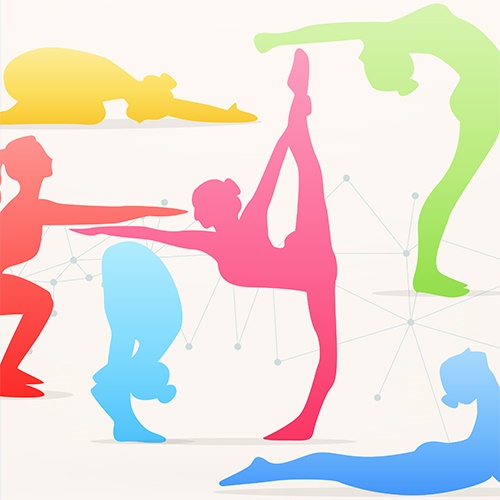

Flexibility is the absolute range of movement in joints that's attainable in a momentary effort with the help of a partner or a piece of equipment.
This tells us that flexibility is not something general, but is specific to a particular joint or set of joints. In other words, it's a myth that some people are innately flexible throughout their entire body.
Being flexible in one particular area or joint doesn't necessarily imply being flexible in another.
Being “loose” in the upper body doesn't mean you will have a “loose” lower body. Furthermore, the flexibility in a joint is also specific to the action performed at the joint (the ability to do front splits doesn’t imply the ability to do side splits even though both actions occur at the hip).
What happens when you stretch
The stretching of a muscle fibre begins with the sarcomere, the basic unit of contraction in the muscle fibre. As the sarcomere contracts, the area of overlap between the thick and thin myofilaments increases.
As it stretches, this area of overlap decreases, allowing the muscle fibre to elongate. Once the muscle fibre is at its maximum resting length (with all the sarcomeres fully stretched), additional stretching places force on the surrounding connective tissue.
As the tension increases, the collagen fibres in the connective tissue align themselves along the same line of force as the tension.So when you stretch, the muscle fibre is pulled out to its full length, sarcomere by sarcomere, and then the connective tissue takes up the remaining slack.
When this occurs, it helps to realign any disorganised fibres in the direction of the tension. This realignment is what helps to rehabilitate scarred tissue back to health.
When a muscle is stretched, some of its fibres lengthen, but other fibres may remain at rest.
The current length of the entire muscle depends on the number of stretched fibres (similar to the way that the total strength of a contracting muscle depends on the number of recruited fibres contracting).
According to SynerStretch you should think of “little pockets of fibres distributed throughout the muscle body stretching, and other fibres simply going along for the ride”. The more fibres that are stretched, the greater the length developed by the stretched muscle.
Types of stretching
1. Static stretching
Static stretching involves gradually easing into the stretch and holding the position. The amount of time a static stretch is held, may be anything from six seconds to two minutes. Often in static stretching you’re advised to move further into the stretch position as the stretch sensation subsides.
2. Ballistic stretching
Ballistic stretching uses the momentum of a moving body or a limb in an attempt to force it beyond its normal range of motion.
3. Dynamic stretching
Dynamic stretching consists of controlled leg and arm swings that take you gently to the limits of your range of motion. Where the event requires a dynamic movement, it’s appropriate and perhaps necessary to conduct dynamic stretching exercises. Start off with the movement at half speed for a couple of repetitions and then gradually work up to full speed.
4. Active stretching
An active stretch is one where you assume a position and then hold it there with no assistance other than using the strength of your agonist muscles. Active stretching is also referred to as static-active stretching.
5. Passive stretching
Passive stretching is also referred to as relaxed stretching, and as static-passive stretching. A passive stretch is one where you assume a position and hold it with some other part of your body, or with the assistance of a partner or some other apparatus.
6. Isometric stretching
Isometric stretching is a type of static stretching which involves the resistance of muscle groups through isometric contractions (tensing) of the stretched muscles.
7. Assisted stretching
Assisted stretching involves the assistance of a partner who must fully understand their role otherwise the risk of injury is high.
8. Partner stretches
Your partner assists you to maintain the stretch position or help you ease into the stretch position as the sensation of stretch subsides. Aim to be fully relaxed and breathe easily through the exercise. Partner-assisted stretches are best used as developmental exercises, with each stretch being held for 30 seconds.
Types of flexibility
Different types of flexibility are grouped according to the various activities involved in athletic training. The ones which involve motion are called dynamic, and others are static. The different types are:
- Dynamic flexibility (also called kinetic flexibility) is the ability to perform dynamic (or kinetic) movements of the muscles to bring a limb through its full range of motion in the joints.
- Static-active flexibility (also called active flexibility) is the ability to assume and maintain extended positions using only the tension of the agonists and synergists, while the antagonists are being stretched. For example, lifting the leg and keeping it high without any external support (other than from your own leg muscles).
- Static-passive flexibility, (also called passive flexibility) is the ability to assume extended positions and then maintain them using only your weight, the support of your limbs, or some other apparatus (such as a chair or a barre). Note that the ability to maintain the position doesn't come solely from your muscles, as it does with static-active flexibility. Being able to perform the splits is an example of static-passive flexibility.





 Publications
Publications
 Partners
Partners










